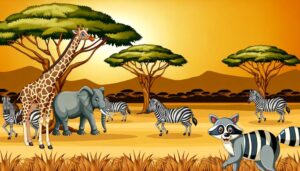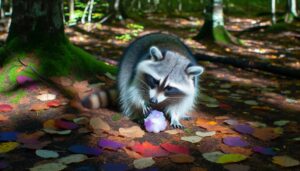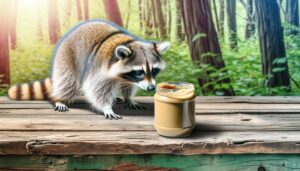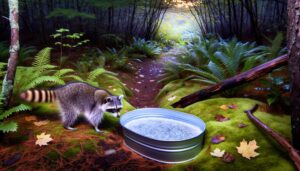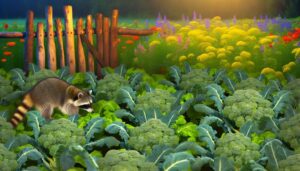How Do Raccoons Live in Alberta Habitats?
Raccoons do live in Alberta, exhibiting remarkable adaptability to the province's varied climates and terrains. They prefer habitats near water bodies and dense vegetation but also thrive in urban environments where food sources like garbage bins and pet food are abundant.
Despite Alberta's harsh winter conditions and diverse landscape, raccoons exploit available resources to survive. Predators and vehicle collisions pose significant threats to their populations.
Effective wildlife management and ongoing research are essential for monitoring raccoon behavior, distribution, and impact. For a deeper insight into raccoon life in Alberta, further information is available.

Key Takeaways
- Raccoons are highly adaptable and can thrive in Alberta's diverse habitats, including urban areas.
- Despite Alberta's harsh winters, raccoons can survive due to their adaptability and ability to find varied food sources.
- They prefer habitats near water bodies and forested regions with dense vegetation.
- Raccoons face threats from predators like coyotes and owls, and high mortality from vehicle collisions.
- Wildlife management in Alberta focuses on monitoring raccoon populations to mitigate public health risks.
Raccoon Habitat Preferences

Although raccoons are highly adaptable creatures, they exhibit distinct preferences for habitats that offer abundant food sources, water, and shelter. Typically, raccoons favor areas near water bodies such as rivers, lakes, and wetlands, which provide essential hydration and a rich variety of food options. Forested regions with dense vegetation and ample tree cover are also preferred, as they offer protection from predators and suitable nesting sites.
Urban environments can attract raccoons due to the availability of human refuse, gardens, and other human-made food sources. In these settings, raccoons often utilize attics, basements, and abandoned structures for shelter. Understanding these habitat preferences is important for evaluating the likelihood of raccoon populations in any given geographic area.
Alberta's Climate and Terrain
Alberta's climate is characterized by harsh winter conditions with temperatures often plummeting well below freezing, posing significant challenges for wildlife survival.
The province also features a diverse landscape that includes prairies, forests, and mountainous regions, each offering unique ecological niches.
These environmental factors play a critical role in determining the presence and distribution of raccoon populations within the region.
Harsh Winter Conditions
The province of Alberta experiences severe winter conditions characterized by sub-zero temperatures, heavy snowfall, and strong winds, creating a challenging environment for wildlife. These harsh conditions impact the survival and behavior of various species.
Several factors contribute to this formidable climate:
- Temperature Extremes: Alberta's winter temperatures can plummet below -30°C, affecting the metabolic rates and thermal regulation of animals.
- Snow Accumulation: Heavy snowfall, often exceeding 100 cm annually, can restrict movement and access to food sources for many species.
- Wind Chill: Strong winds worsen the cold, leading to even lower effective temperatures and increased energy expenditure for thermoregulation.
Understanding these elements is essential for comprehending the survival strategies employed by wildlife in Alberta's rigorous winter environment.
Diverse Landscape Features
In contrast to the harsh winter conditions, Alberta's diverse landscape features a range of climate zones and terrain types, from the Rocky Mountains to the prairies, each offering unique habitats for wildlife. The province encompasses various ecosystems, including forests, grasslands, and wetlands, which support different flora and fauna. This diversity impacts the distribution and behavior of species such as raccoons.
| Climate Zone | Terrain Type |
|---|---|
| Rocky Mountains | Alpine |
| Foothills | Mixed Forest |
| Prairies | Grasslands |
| Boreal Forest | Coniferous Forest |
These distinct regions provide varied microhabitats, influencing the adaptability and survival of raccoons. While the mountainous and forested areas may offer ample cover and food sources, the open prairies present challenges due to exposure and limited den sites.
Historical Raccoon Sightings

Historical raccoon sightings in Alberta provide valuable insights into their presence and distribution. Early documented sightings trace back several decades, with increased observations in urban areas suggesting adaptation to human environments.
Additionally, seasonal patterns in sightings indicate fluctuations in raccoon activity, influenced by climatic and ecological factors.
Early Documented Sightings
Raccoon sightings in Alberta were first recorded in the early 20th century, marking the initial evidence of their presence in the region. These early observations provide critical insights into the species' historical distribution and migration patterns.
Key documented sightings include:
- 1920s: Farmers in southern Alberta reported occasional raccoon encounters near their properties, suggesting an initial, sporadic presence.
- 1940s: Naturalists observed raccoons along riverbanks and wooded areas, indicating a gradual adaptation to local ecosystems.
- 1960s: Increased sightings in provincial parks pointed to a steady population growth and broader habitat range.
These historical records are essential for understanding the raccoon's establishment and ecological impact in Alberta, laying the groundwork for further studies on their adaptation and proliferation.
Sightings in Urban Areas
Urban sightings of raccoons in Alberta have become increasingly common, reflecting their ability to adapt to human-altered environments. Initially considered rare, the frequency of raccoon encounters in cities such as Calgary and Edmonton has risen.
These omnivorous mammals exploit various urban resources, including garbage bins and pet food, demonstrating behavioral plasticity. Data from local wildlife control agencies indicate a notable increase in raccoon-related service calls over the past decade.
Observations reveal raccoons utilizing green spaces, storm drains, and abandoned structures for shelter. Their nocturnal habits and versatile diet facilitate their survival in urban landscapes.
Such adaptability underscores the importance of monitoring urban wildlife dynamics and implementing measures to mitigate potential human-wildlife conflicts.
Seasonal Sightings Patterns
Analyzing seasonal sighting patterns reveals fluctuations in raccoon activity throughout the year, influenced by factors such as temperature, food availability, and breeding cycles. Historical data indicate that raccoon sightings in Alberta vary significantly with the changing seasons.
Notable patterns include:
- Spring (March-May): Increased sightings due to raccoons emerging from winter dens and seeking food, coinciding with the breeding season.
- Summer (June-August): Peak activity as abundant food sources and warmer temperatures support higher raccoon mobility and visibility.
- Winter (December-February): Reduced sightings, as raccoons enter a period of torpor, minimizing activity and foraging to conserve energy.
These patterns are essential for understanding raccoon ecology in Alberta, aiding in wildlife management and public awareness initiatives.
Urban Vs. Rural Presence
Examining the distribution patterns of raccoons in Alberta reveals a marked difference between their urban and rural habitats. In urban areas, raccoons are frequently observed exploiting anthropogenic resources, including garbage, pet food, and shelter opportunities provided by human structures. Urban environments offer consistent food sources and fewer natural predators, facilitating raccoon population growth.
Conversely, in rural regions, raccoons are less prevalent due to limited access to reliable food sources and increased predation risks from larger wildlife. Rural habitats also lack the abundance of artificial shelters found in urban settings, reducing raccoon survival rates.
This dichotomy underscores the adaptability of raccoons to human-modified landscapes, where they thrive more readily compared to their rural counterparts.
Food Sources in Alberta

In both urban and rural areas of Alberta, the availability and type of food sources play a significant role in determining raccoon distribution and behavior. Raccoons are opportunistic feeders, capable of adapting to various environments based on food accessibility.
In Alberta, their diet mainly consists of:
- Natural Foraging: Fruits, nuts, and insects available in forests and open fields.
- Aquatic Resources: Crayfish, frogs, and small fish found in rivers and streams.
- Human-Provided Food: Waste from garbage bins, pet food, and bird feeders in urban settings.
These varied food sources enable raccoons to thrive in diverse habitats by exploiting whatever is abundant. Consequently, their presence in Alberta is closely tied to the abundance and variety of these nutritional resources.
Predators and Threats
Various natural predators and human activities pose noteworthy threats to raccoons in Alberta. Predatory species such as coyotes, owls, and large hawks are known to hunt raccoons, particularly targeting juveniles. Additionally, domestic dogs can pose a considerable threat when raccoons venture into urban or suburban areas.
Human activities, including road traffic, habitat destruction, and environmental pollution, exacerbate these risks. Mortality due to vehicle collisions is notably high, as raccoons often forage near roads. Habitat fragmentation reduces available shelter and food sources, making raccoons more vulnerable to predation and environmental stress.
Moreover, indiscriminate trapping and poisoning efforts aimed at pest control can inadvertently harm raccoon populations. Thus, both natural and anthropogenic factors have a significant impact on raccoon survival in Alberta.
Breeding and Offspring
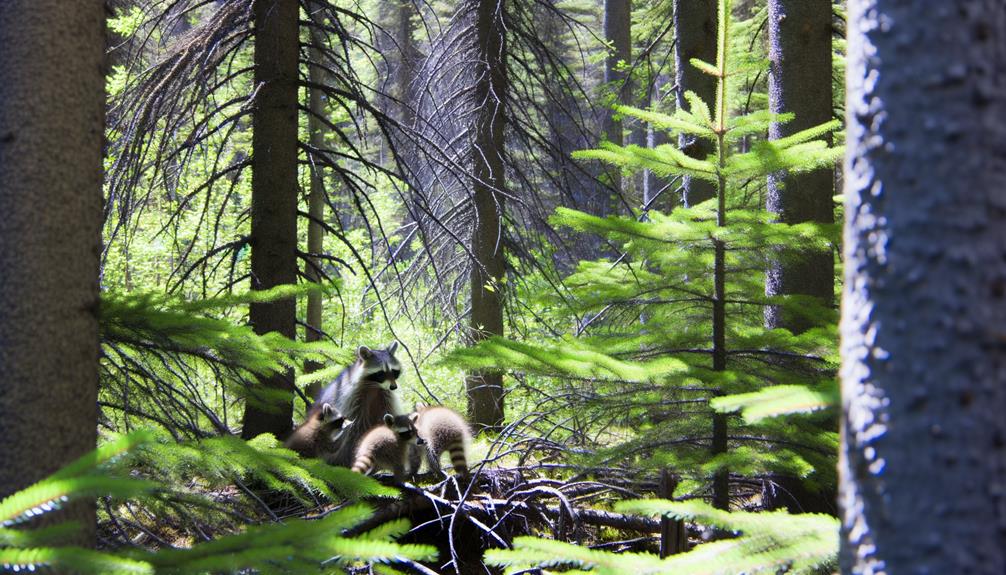
Raccoons typically breed from late winter to early spring, with the timing slightly variable depending on geographic location.
A female raccoon usually gives birth to a litter ranging from two to five offspring after a gestation period of approximately 63 days.
The mother is solely responsible for the care and nurturing of the young, who remain dependent on her for several months before becoming independent.
Breeding Season Timing
Breeding season for raccoons in Alberta typically begins in late winter, extending into early spring, with female raccoons giving birth after a gestation period of approximately 63 days. This timing ensures that offspring are born during a period of increasing food availability and milder weather.
The breeding season involves several key stages:
- Mating Behavior: Courtship and mating behaviors are observed starting in late January, marked by increased vocalizations and interactions between males and females.
- Gestation: The gestation period lasts about 63 days, during which the female prepares a secure den for birthing and rearing the young.
- Post-birth Care: After birth, the mother provides intensive care, including nursing and protecting the young, until they are self-sufficient.
These stages are crucial for the survival and development of the offspring.
Typical Litter Size
Typically, female raccoons in Alberta give birth to litters ranging from two to five offspring, with an average litter size of about three to four kits. This fecundity is consistent with raccoon populations in other regions, reflecting their adaptable reproductive strategies.
Raccoons generally mate from late winter to early spring, with a gestation period of approximately 63 days. The birth of the kits usually occurs in late spring. Neonatal raccoons are altricial, meaning they are born blind, deaf, and reliant on maternal care.
The survival rate of the kits can be influenced by various factors, including environmental conditions, availability of food, and predation pressures. Understanding litter size is vital for managing raccoon populations and predicting their ecological impact in Alberta.
Care of Young
Following the birth of the kits, maternal care becomes crucial as the altricial young require continuous attention and nurturing to guarantee their survival and growth. The mother raccoon, or dam, provides essential care through several key behaviors:
- Nourishment: The dam nurses her kits with high-fat milk, which is crucial for rapid growth during the initial weeks.
- Protection: The mother remains vigilant, often relocating her litter to multiple den sites to evade predators and environmental threats.
- Teaching: As the kits mature, the dam introduces them to foraging and survival skills, gradually encouraging independence.
These maternal behaviors are important for the developmental stages of the kits, ensuring they reach a level of self-sufficiency necessary for eventual dispersal from the natal area.
Wildlife Management Policies
Implementing effective wildlife management policies is essential for maintaining the ecological balance and addressing the presence of raccoons in Alberta. These policies involve coordinated efforts between governmental agencies, non-governmental organizations, and local communities.
Key strategies include habitat management, population control, and public education. Habitat management guarantees that raccoon populations do not disrupt local ecosystems by preserving natural areas and minimizing human-wildlife conflicts.
Population control measures, such as regulated trapping and relocation, help prevent overpopulation and associated problems. Public education campaigns inform residents about raccoon behavior, safety measures, and the importance of not feeding wildlife.
These combined efforts aim to create a sustainable coexistence between raccoons and Alberta's diverse ecosystems, securing long-term ecological health.
Research and Studies
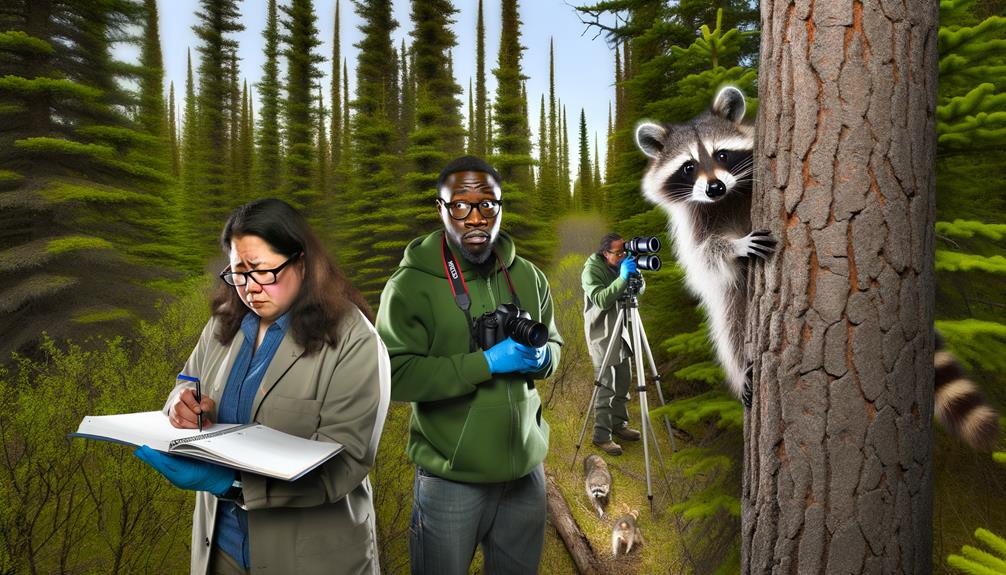
Extensive research and studies have been conducted to understand raccoon behavior, distribution, and ecological impact in Alberta. The findings provide valuable insights into how raccoons adapt to various environments and their interactions with native species.
Key research areas include:
- Habitat Utilization: Studies have identified the types of habitats raccoons prefer, such as urban areas, forests, and wetlands, highlighting their adaptability to both natural and human-modified landscapes.
- Dietary Habits: Research has documented raccoons' opportunistic feeding behaviors, which include a varied diet of fruits, insects, small mammals, and human waste, impacting local biodiversity.
- Disease Transmission: Investigations into raccoons as vectors for diseases like rabies and leptospirosis emphasize the importance of monitoring their populations to mitigate public health risks.
Future Predictions
Building on the existing research, future predictions about raccoon populations in Alberta focus on potential changes in their distribution, behavior, and ecological impact under various environmental and anthropogenic pressures.
Climate change may alter habitat suitability, potentially expanding their range northward.
Urbanization could lead to increased human-wildlife interactions, as raccoons are highly adaptable to urban environments.
Additionally, shifts in available food sources and predation pressures may influence raccoon behavior and population dynamics.
Monitoring these factors is vital for managing any potential ecological impacts, such as competition with native species or the spread of diseases.
Continued research and adaptive management strategies will be essential to understanding and mitigating the future implications of raccoon presence in Alberta.
Conclusion
To sum up, raccoons' adaptability allows them to inhabit diverse environments, including Alberta's varied climate and terrain.
Historical sightings and current data suggest a growing presence in both urban and rural areas, supported by abundant food sources and favorable breeding conditions.
Wildlife management policies and ongoing research will play pivotal roles in shaping future interactions.
As the adage goes, 'where there's a will, there's a way,' and raccoons exemplify this resilience, continually adapting to the changing landscapes of Alberta.

